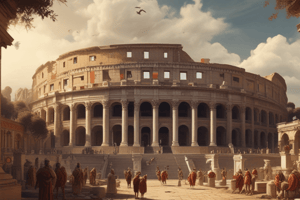Podcast
Questions and Answers
Where is Rome located geographically?
Where is Rome located geographically?
Rome is located in central Italy, in the Lazio region, near the Tiber River.
What was the impact of slavery on the Roman economy and society?
What was the impact of slavery on the Roman economy and society?
Slavery played a significant role in the Roman economy, as slaves made up a substantial portion of the workforce, but it also led to social and economic problems.
Describe the three branches of government in ancient Rome.
Describe the three branches of government in ancient Rome.
The three branches were: 1) The Consuls (executive), 2) The Senate (legislative), and 3) The Assemblies (judicial).
How did Hannibal invade Italy during the Second Punic War?
How did Hannibal invade Italy during the Second Punic War?
What was the main reason for the conflict between Pompey and Caesar?
What was the main reason for the conflict between Pompey and Caesar?
What geographic feature is Rome situated near, and how did it influence the city's development?
What geographic feature is Rome situated near, and how did it influence the city's development?
In what ways did the institution of slavery shape the social and economic dynamics of ancient Rome?
In what ways did the institution of slavery shape the social and economic dynamics of ancient Rome?
What were the primary responsibilities of the Consuls, the Senate, and the Assemblies in the Roman government, and how did they interact with one another?
What were the primary responsibilities of the Consuls, the Senate, and the Assemblies in the Roman government, and how did they interact with one another?
What was the motivation behind Hannibal's invasion of Italy during the Second Punic War, and what were the consequences of his actions?
What was the motivation behind Hannibal's invasion of Italy during the Second Punic War, and what were the consequences of his actions?
What role did personal ambition and rivalry play in the conflict between Pompey and Caesar, and what were the consequences of their struggle for power?
What role did personal ambition and rivalry play in the conflict between Pompey and Caesar, and what were the consequences of their struggle for power?
Flashcards are hidden until you start studying
Study Notes
Geography of Rome
- Rome lies on the Italian Peninsula, in the central part of Italy.
- The city is situated on the banks of the River Tiber, about 24 kilometers (15 miles) inland from the Mediterranean Sea.
Slavery in the Roman Empire
- Slavery was a widespread and essential part of the Roman Empire's economy and social structure.
- Slaves in ancient Rome came from various sources, including war captives, slaves born in captivity, and people who sold themselves into slavery to pay off debts.
Three Branches of the Roman Government
- The Roman government consisted of the Legislative, Executive, and Judicial branches.
- The Legislative branch was the Roman Senate, composed of patrician (noble) men who advised the consuls and made laws.
- The Executive branch was held by the two consuls, who were elected by the people and held supreme power for a one-year term.
- The Judicial branch was made up of praetors, who presided over courts and interpreted laws.
Hannibal's Invasion of Italy
- Hannibal, a Carthaginian general, invaded Italy in 218 BCE during the Second Punic War.
- He led an army of 40,000 soldiers, 12,000 cavalry, and 37 war elephants across the Alps from Spain.
Pompey and Caesar's Conflict
- Pompey and Caesar, two powerful Roman generals, fought against each other in a civil war from 49 to 45 BCE.
- The conflict was sparked by Caesar's ambition to become dictator of Rome, which Pompey and his followers opposed.
Julius Caesar
- Julius Caesar was a Roman general and statesman who transformed the Roman Republic into the Roman Empire.
- He was appointed dictator of Rome for life in 44 BCE, but was assassinated by a group of senators on the Ides of March (March 15) in the same year.
Studying That Suits You
Use AI to generate personalized quizzes and flashcards to suit your learning preferences.




